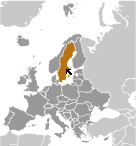World Atlas: Sweden. On this page you can see the map, country flag and many detailed information about the people, history and economy of Sweden.

Here you can find online selected information about the geography, inhabitants, government, economy and history of Sweden. Included are selected statistics, an overview map and the detailed map of Sweden. But let's start with the flag of Sweden here:
Sweden - Overview:
What you should know about Sweden? Let's start with this: A military power during the 17th century, Sweden has not participated in any war for two centuries. An armed neutrality was preserved in both world wars. Sweden's long-successful economic formula of a capitalist system intermixed with substantial welfare elements was challenged in the 1990s by high unemployment and in 2000-02 and 2009 by the global economic downturns, but fiscal discipline over the past several years has allowed the country to weather economic vagaries. Sweden joined the EU in 1995, but the public rejected the introduction of the euro in a 2003 referendum.
Geography of Sweden
 Where on the globe is Sweden? The location of this country is Northern Europe, bordering the Baltic Sea, Gulf of Bothnia, Kattegat, and Skagerrak, between Finland and Norway. Total area of Sweden is 450,295 sq km, of which 410,335 sq km is land. So this is quite a large country. How could we describe the terrain of the country? This way: mostly flat or gently rolling lowlands; mountains in west. The lowest point of Sweden is reclaimed bay of Lake Hammarsjon, near Kristianstad -2.4 m, the highest point Kebnekaise 2,111 m. And the climate is temperate in south with cold, cloudy winters and cool, partly cloudy summers; subarctic in north.
Where on the globe is Sweden? The location of this country is Northern Europe, bordering the Baltic Sea, Gulf of Bothnia, Kattegat, and Skagerrak, between Finland and Norway. Total area of Sweden is 450,295 sq km, of which 410,335 sq km is land. So this is quite a large country. How could we describe the terrain of the country? This way: mostly flat or gently rolling lowlands; mountains in west. The lowest point of Sweden is reclaimed bay of Lake Hammarsjon, near Kristianstad -2.4 m, the highest point Kebnekaise 2,111 m. And the climate is temperate in south with cold, cloudy winters and cool, partly cloudy summers; subarctic in north.
Inhabitants of Sweden
Let's take a look how many people live in Sweden. The number is: 9,960,487 (July 2017 est.). So this is not very populous country. Who lives here? indigenous population: Swedes with Finnish and Sami minorities; most common countries of origin among immigrants: Finland, Syria, Iraq, Poland, Iran. What are the languages in Sweden? Swedish (official). And the religions: Church of Sweden (Lutheran) 63%, other (includes Roman Catholic, Orthodox, Baptist, Muslim, Jewish, and Buddhist) 17% (2016 est.). How old are the people in average? 41.2 years. We have to add that this number is the median - so one half of the people is older than this, one half is younger. And what is their life expectancy (at birth)? This: 82.1 years. Where the people live in Sweden? Here: most Swedes live in the south where the climate is milder and there is better connectivity to mainland Europe; population clusters are found all along the Baltic coast in the east; the interior areas of the north remain sparsely populated. The major urban areas of Sweden are: Stockholm (capital) 1.486 million (2015).
Government and Economy of Sweden
The capital of Sweden is Stockholm and the government type parliamentary constitutional monarchy. Let's take a look at the administrative divisions - 21 counties (lan, singular and plural); Blekinge, Dalarna, Gavleborg, Gotland, Halland, Jamtland, Jonkoping, Kalmar, Kronoberg, Norrbotten, Orebro, Ostergotland, Skane, Sodermanland, Stockholm, Uppsala, Varmland, Vasterbotten, Vasternorrland, Vastmanland, Vastra Gotaland. Regarding the economy of Sweden, important industrial products are iron and steel, precision equipment (bearings, radio and telephone parts, armaments), wood pulp and paper products, processed foods, motor vehicles. Important agricultural products are barley, wheat, sugar beets; meat, milk. The most important export commodities are machinery 35%, motor vehicles, paper products, pulp and wood, iron and steel products, chemicals (2012 est.) and the most important export partners are Germany 10.6%, Norway 10.4%, US 7.3%, Denmark 7%, Finland 6.8%, UK 6%, Netherlands 5.4%, Belgium 4.7%, France 4.4% (2016). The most important import commodities are machinery, petroleum and petroleum products, chemicals, motor vehicles, iron and steel; foodstuffs, clothing and the most important import partners are Germany 18.8%, Netherlands 8.2%, Norway 7.8%, Denmark 7.6%, China 5.6%, UK 5.2%, Belgium 4.6%, Finland 4.5%, France 4.1% (2016). How rich is Sweden and how rich are people in this country? The most important number here is GDP per capita (PPP): $51,300 (2017 est.). This means the people are rich on average here. Let's add that this means Gross Domestic Product per person, which is recalculated with respect to the relative cost of local goods and services. And one more important number - population below poverty line: 15% (2014 est.).